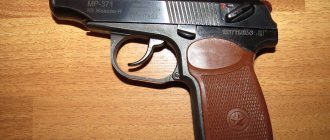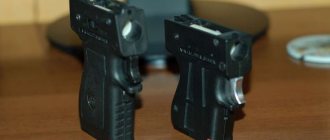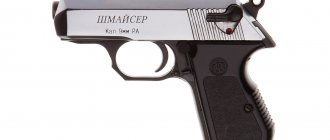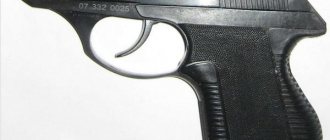Glock is a family of pistols that was created for the needs of the Austrian army. Glock became the first prototype of a weapon developed by this company. The resulting standard turned out to be quite successful and also convenient for implementation, as a result of which it was adopted under the designation P80 for service with the Austrian army. The Glock pistols later became widely known due to their combat properties and the frequent use of this weapon in various Hollywood films. The Glock 17 combat pistol has become quite widespread in the world.
Now there are a huge number of different versions of this pistol, which are designed for different cartridges (.45ACP, .357 SIG, 10 mm auto, .40 S&W, 9x19 mm Parabellum and others). All models of Glock pistols differ in design completely slightly from the basic standard Glock 17. Glock pistols are distinguished by their conventional design and low weight. The Glock 17 contains only 33 parts, including the magazine, so it can be disassembled one hundred percent in less than a minute.
History of the creation of trauma
After World War II, Austrian police officers had a problem with weapons. Only Walther pistols of the PP and PPK series, produced in the pre-war years, were in service. To remedy the situation, the Austrian authorities in 1980 announced an engineering competition to create a pistol for the police.
The competition attracted the attention of many gun manufacturers. One of the participants was the small company Glock in those years, which opened in the city of Deutsch-Wagram in 1963. The owner of the company, Gaston Glock, gave the engineers a clear task: to design an easy-to-use, functional and reliable pistol.
The result of the engineers' work was the Glock-17 pistol, which differs from previous models in the predominance of impact-resistant plastic in the design. In 1982, having successfully passed tests, the pistol became part of the Austrian army weapons. 25 thousand weapons were immediately ordered from Glock. The modest brand was technically not ready for such large orders, so at first it used the help of other manufacturers.
When the first model became popular, the Glock company began to expand its model range and improve the technical characteristics of pistols. But the design of all produced models remained based on those successful technical parameters that were used to create the Glock-17.
The number “17” in the name of the pistol is the number of the folder of technical documents on the basis of which the traumatic model began to be produced.
In 2011, the Turkish manufacturer Target Technologies opened a line of traumatic weapons developed on the basis of the Austrian Glock. The model was called Zoraki 917. Since certification of weapons produced outside the country is unacceptable in Russia, in 2012 the Lyubertsy enterprise Okhota began production of the licensed Phantom-T traumatic pistol - this is actually the same Glock. based on the Glock-17, she created the 717T pistol.
Glock is a ceramic pistol from Germany
In 1980, the Austrian army announced a competition for a new army pistol. A military order is a tasty morsel for any weapons manufacturer, which is why such well-known companies in the weapons community as Heckler & Koch and Steyr showed interest in it. All the more surprising is the fact that two years later the winner was a previously unknown manufacturer of knives, sapper blades and other army equipment - the Austrian one (Glock GmbH).
Photo: Glock 19 - a compact modification of the original Glock 17, distinguished by a shortened barrel (102 mm versus 114 mm) and a standard 15-round magazine instead of the 17-round magazine of the Glock 17
The pistol presented by the company for testing was made with extensive use of reinforced plastics - however, by this time the Austrian army had already adopted the Steyr AUG assault rifle with a body made of impact-resistant plastic, so this fact did not particularly frighten the military. But thanks to this, the “plastic” pistol turned out to be relatively light and inexpensive. In addition, it was distinguished by ease of disassembly, which did not require additional tools, reliability and simplicity - the total number of parts was only 33.
Photo: Glock 30 - subcompact model chambered for .45 ACP
Another distinctive feature of the new pistol was the complete absence of traditional external manual safeties - instead, the Glock was equipped with three independent automatic safeties. In particular, the trigger safety locks it if pressed incorrectly. This approach has significantly simplified the use of the pistol - the shooter just needs to insert the magazine and fire the cartridge, after which no additional manipulations with the triggers or safeties are required - you just need to press the trigger.
Photo: Glock 31 - a variant of the standard model chambered for .357 SIG
Following Austria, the armies of Sweden and Norway became interested in the new pistol. The Danish contract was a good advertisement: Glocks chambered for 10mm Auto were purchased to arm the Sirius ski patrol, a unit patrolling the northern and eastern parts of Greenland on dog sleds. However, Glock's real triumph was its breakthrough into the US market. The combination of price, reliability and, last but not least, a successful marketing strategy led to the fact that police departments and the FBI began to purchase Glocks. Following the police, civilians also became interested in the new pistol.
Photo: Glock 34 - a sports model chambered for 9×19 mm Parabellum
According to the American ATF (the federal agency that controls the circulation of alcohol, tobacco, firearms and explosives), in 2014 alone, more than 230,000 Glocks were produced in the United States, and almost 800,000 pistols were exported from Austria - however, to this number may also include products. However, Glock also does not forget about other countries - its products can be found all over the world, from the above-mentioned snows of Greenland to the sands of Iraq.
In Russia, Glocks were initially purchased only for special forces of law enforcement agencies, but recently several models of the company have been certified as sporting weapons and have become available to ordinary citizens - however, only for sporting purposes and with club storage.
Photo: Glock 42 and Glock 43 are two sub-compact “slim” models chambered for .380 ACP and 9x19mm Parabellum, respectively. These are the first Glock models to accept a single-stack magazine with a capacity of six rounds.
With all the wealth of choice...
Glock’s choice is truly rich - today the company’s line includes about 40 models, from the sporty Glock 34 to the latest new product, the baby Glock 43, the first of the large Glock family of pistols with a single-stack magazine for six 9x19 mm cartridges Parabellum. Its weight without cartridges is only 460 grams!
Happy owners talk long and willingly about the merits of their pistols. Firstly, it is an almost endless – at least relative to the average consumer’s demands – resource. The Austrian military insisted on 40,000 rounds, but the guarantee covers them. As for the maximum possible shot, there are a variety of numbers here. Depending on the details of operation, the cartridges used and other conditions, we can say that on average a Glock “lives” from 100,000 to 200,000–250,000 shots before serious defects appear.
Equally laudatory words can be said about the reliability of the Glock - one of the favorite topics among fans of these pistols is stories about how many shots have passed since the last cleaning. As a rule, we are talking about thousands.
The advantages include the already mentioned absence of mechanical fuses: a Glock with a chambered cartridge is in constant readiness to fire.
Finally, if you are not a practicing athlete who shoots thousands of rounds of ammunition every month, or not a special forces officer with similar access to the “infinite ammunition” option at the expense of the state treasury, then it is worth remembering the weight of the weapon - carry extra in a holster every day “just in case.” A few hundred grams is not that hard, but annoying. And the issue of price, when you pay out of your own pocket, is by no means in last place!
In general, if you listen to Glock fans, you begin to believe that the ideal pistol really exists, and the only thing that is not yet available to it is the ability to bring freshly brewed coffee to its owner in the morning. In fact, this, of course, is not entirely true, and many of the disadvantages of the Glock are a continuation of its advantages.
Everything is not so clear
One of the possible problems is under-priming of the cartridge primer. The scheme used in the Glock with preliminary partial cocking of the firing pin keeps its spring under constant tension, which after some time naturally leads to its subsidence. With high-quality cartridges this is unlikely to manifest itself in any way, but with not very good ones... The author once personally observed how the police officers shooting next to him looked in surprise at the dents on the cartridges from the next batch of the Barnaul Cartridge Plant - they misfired 2-3 per pack 50 rounds. Clogging of the firing pin channel with soot from “dirty” cartridges also leads to a similar result, but many Glock owners, as mentioned above, sincerely believe that it is not at all necessary to clean their “ideal pistol” an extra – read, after firing 500 – times.
Another source of problems, which is also typical for other pistols with a plastic frame, is sensitivity to the correct grip. This drawback is the subject of fierce debate on weapons forums, so it is easier for the author to refer to personal experience. The shortness of the shutter on Glocks was often observed both in novice shooters and in experienced shooters who were forced to change the method of holding - for example, if at a competition the conditions of the exercise required shooting from a “weak” hand. As a rule, the problem is eliminated simply by hitting the bolt - but often the shooter, faced with a delay in the “ideal pistol,” falls into a stupor for a while.
Photo: fire mode translator.
The above problems more often hit the shooter’s nerves than their health - unless, of course, they happen during a firefight. However, there is a much more traumatic problem: the safety on the trigger reliably protects against a shot if pressed incorrectly, but... “cases are different.” For example, if you try to put a Glock in a holster without removing your finger from under the brace, it will most likely cost a hole in your leg. Also at risk are owners of soft holsters that can become deformed - as practice shows, an unsuccessful fold can squeeze the trigger no worse than a finger. On the other hand, this problem can hardly be called specific to Glocks. If a person somehow manages to pull the trigger of a pistol at the wrong time, he no longer has the main fuse - in his head.
However, millions of people around the world successfully use Austrian pistols, without even knowing about the listed shortcomings. After all, even their predecessor in the company’s track record – a mining shovel – requires a bit of attention and care from its owner to work well. A pistol, even one as simple and reliable as a Glock, is a little more complex than a shovel. If you remember this, then... welcome to the club of people who believe that anyone can have a truly good pistol, as long as it has the inscription “GLOCK” on it.
Description and purpose of the Glock pistol
The Glock-17 model, which turned out to be technically successful and easy to use, became widespread not only as part of the armament of the Austrian army under the number P80, but also as an effective means of civil self-defense. The Glock company has developed several variations of the pistol for different types of cartridges.
The main design feature is the absence of a trigger. Since the safety is hidden in the trigger mechanism, it is impossible to fire without pressing the trigger all the way. The main material used to make the gun is high-strength plastic that can withstand temperatures up to 200 °C. The weapon is durable, reliable, and not heavy. Consists of 33 elements.
The Glock pistol fires underwater at a depth of up to 3 m without bursting the barrel when using bullets with a solid jacket. For normal functioning of the capsule, a firing pin with transversely directed grooves is required.
Today there are 5 generations of Glock-17. A modern buyer can purchase a 3rd, 4th, 5th generation injury.
Why are Austrian Glock pistols so popular all over the world?
The incredible popularity of the Glock pistol is due to the fact that all the models produced by this Austrian company are highly reliable and unpretentious, which is quite a rarity among modern Western pistols. The Glock-17 pistol is considered the most popular and reliable, although other models are also quite reliable.
Many world experts in the field of weapons consider Glock pistols to be the best pistols in the world, as they have the following characteristics:
- Glock pistols are capable of working in the most difficult conditions;
- The excellent tactical and technical characteristics of these pistols ensure accuracy of both aimed and offhand shooting;
- The safety of Glock pistols is at the highest level due to the design features;
- Safety and comfort of wearing, both small models of pistols and full-size modifications;
- Ease of handling the weapon, including its maintenance;
- High service life of all Glock models;
- Wear resistance of all parts of the pistol. The coating of the steel parts of the gun perfectly resists corrosion;
- Quite low cost, although compared to domestic pistols this point is not very relevant.
Glock pistols are excellent military weapons of choice for professional special forces soldiers around the world. The ability to use this pistol with a silencer and the absence of problems during operation made it a favorite weapon for special operations and one of the most beloved among the civilian population of those countries where the carrying of short-barreled weapons is permitted. For those people who do not have the opportunity to frequently train with weapons, they need just such an easy-to-use pistol.
There are many different models of Glock pistols, which are intended for both military and police service, and for self-defense. The most popular models of Glock pistols are:
- "Glock-17", which brought glory to the Austrian, which has the ability to fire in bursts. This model was created on the basis of the Glock-17, specifically for the Austrian special forces Cobra;
- The Glock-19 pistol is a more compact model of the Glock-17 pistol. Features a shorter pistol grip and shorter bolt length;
- The Glock 26 pistol is one of the company’s most compact models. It is quite popular among women for self-defense and as a last-resort concealed weapon for various undercover agents.
The popularity of Glock pistols is evidenced by the fact that more than 50 percent of all pistols sold in the United States are Glocks. Pistols from this company are distinguished by stable accuracy, and you don’t even need to shoot them. By purchasing a Glock pistol, you can be sure that it will shoot accurately on target.
Although the performance characteristics of Glock pistols satisfy even the most demanding critics, controversy still rages about its appearance. The design of Glock pistols is quite interesting, although monotonous. Many modern pistols look more attractive than the ascetic Glocks, the design of which is strictly functional and has only one goal - to make the pistol simple and easy to use.
The Glock pistol does not have a safety lock, and it can be fired immediately after being snatched. At the same time, it is extremely safe, since the shot will only fire when the trigger is fully pressed. Most people who have been able to try Glocks in action usually immediately choose these pistols as their main or backup weapon.
Specifications
The Austrian traumatic pistol is deservedly considered one of the most successful.
In our country, at first this weapon was used only by special forces soldiers, but after a while it became a means of civilian self-defense. The Glock-17 is almost no different from a similar combat model; it has a steel frame with a plastic coating, an anatomically shaped handle, and a square bolt. The main technical characteristics are given below.
| Characteristics | Values |
| weight without cartridges | 0.6 kg |
| weight with cartridges | 0.9 kg |
| total length | 20.4 cm |
| barrel length | 11.4 cm |
| height | 13.8 cm |
| width | 3.3 cm |
| caliber | 9 mm |
| cartridges | 9×19 Parabellum |
| departure launch speed | 375 m/s |
| sight range | 50 m |
| shop | for 17, 19, 33 rounds |
| aim | open, detachable |
Design
The Glock-17 pistol operates on the basis of recoil with a short displacement of the barrel. This is ensured by the modernized Colt-Browning design. The barrel is locked by lowering its breech element, inserted as a rectangle into the bolt passage, which ejects spent cartridges. The cross-section of the trunk is oval in the front, square in the back. The diameter at the front narrows to 5 mm, which does not allow the use of live ammunition.
The barrel does not provide jumpers. The thickness of its walls is 2.5 mm, the liner is similar. The barrel surface is not susceptible to corrosion. The magazine cover latch and bolt stop are located on the left side.
A striker-type trigger mechanism is inserted, which functions as follows: the striker is partially cocked, at the same time the bolt is retracted, then additional cocking is carried out by applying pressure on the trigger. When the shooter presses his finger on the hook, the firing pin lock is released, then the cocking is released, and the pistol fires.
In fact, the Glock-17 is a typical single-action trigger, but supplemented with an additional cocking mechanism. The Glock rifle has 3 separate safeties that make up the “Safe Action” system: automatic, shockproof, and a safety lever. Fixed sighting devices are installed: plastic rear sight and front sight. Under the barrel there is a Picatinny rail mount that allows you to attach a flashlight and laser pointer.
Design Features of the Glock 17
- Automatic operation on all Glock pistol models works due to the recoil of its short barrel stroke. Otherwise, they differ only in magazine capacity, caliber and barrel length (not counting the Glock 18, which is capable of automatic firing, its rate of fire is 1100 rounds/min).
- The automatic safety, which is combined with the trigger, deserves attention. It turns off after pressing the safety and the trigger simultaneously.
- The magazine eject button is located on the left side of the frame below the trigger guard; you can simply press it with the finger of your right hand.
- Despite the higher magazine capacity, the Glock pistol is lighter than pistols from other manufacturing companies. This indicator is ensured by the widespread use of composite materials. Magazines are also made from composite materials.
- The trigger guard has a protrusion for the finger of the 2nd hand when shooting with two hands; in front of the pistol grip there are protrusions for the shooter’s fingers. The sight is not adjustable, open.
Disassembling the Glock
All variations of the Glock model are analyzed using the same algorithm. Before starting work, it is recommended to wear safety glasses to protect your eyes from accidentally jumping springs and splashing lubricant.
Usually the gun is disassembled to thoroughly clean it. Here are the step-by-step instructions:
- Point the weapon where there are no people or animals. Keep your fingers away from the trigger and safety.
- Get the store.
- Move the bolt carrier back and lock it in the open position with the bolt lever.
- Look into the chamber and make sure there are no cartridges inside.
- Remove the bolt carrier. Pull it towards you to release the flag. Press the trigger to release the firing pin.
- Hold the pistol grip with your thumb and the top of the frame with the remaining fingers of one hand. Move the bolt carrier back 3mm.
- Pull down the bolt release. With your other hand, push the shutter flag down. Pull the frame forward with the 4 fingers you are holding it with so that it comes off the receiver.
- Remove the spring by pulling it forward slightly.
- Pull the barrel out of the frame.
- Clean the gun.
- Assemble the weapon using the same method, only in a different sequence.
Advantages and disadvantages
Like any weapon, the Glock traumatic pistol has advantages and disadvantages.
| pros | Minuses |
| accuracy, power and impressive range | dimensions not typical for traumatic weapons |
| structural strength | poorly pressed shutter delay button |
| magazine that holds a large number of cartridges | low strength of shutter materials |
| reliable fuse system | atypical sized cartridges |
| ergonomic handle | the store sometimes falls out |
The Glock is a great option for a beginner who needs a weapon for shooting practice. This pistol is often used by filmmakers as a weapon prop on filming. But it is not common among us as a means of self-defense, although it is intended for this purpose. Users believe that an experienced attacker can easily determine by the appearance of a pistol that it is traumatic.











